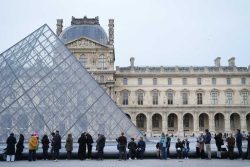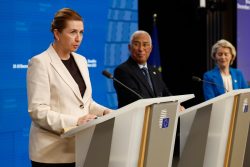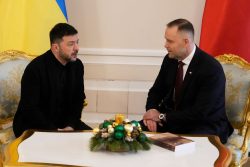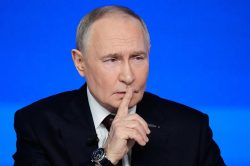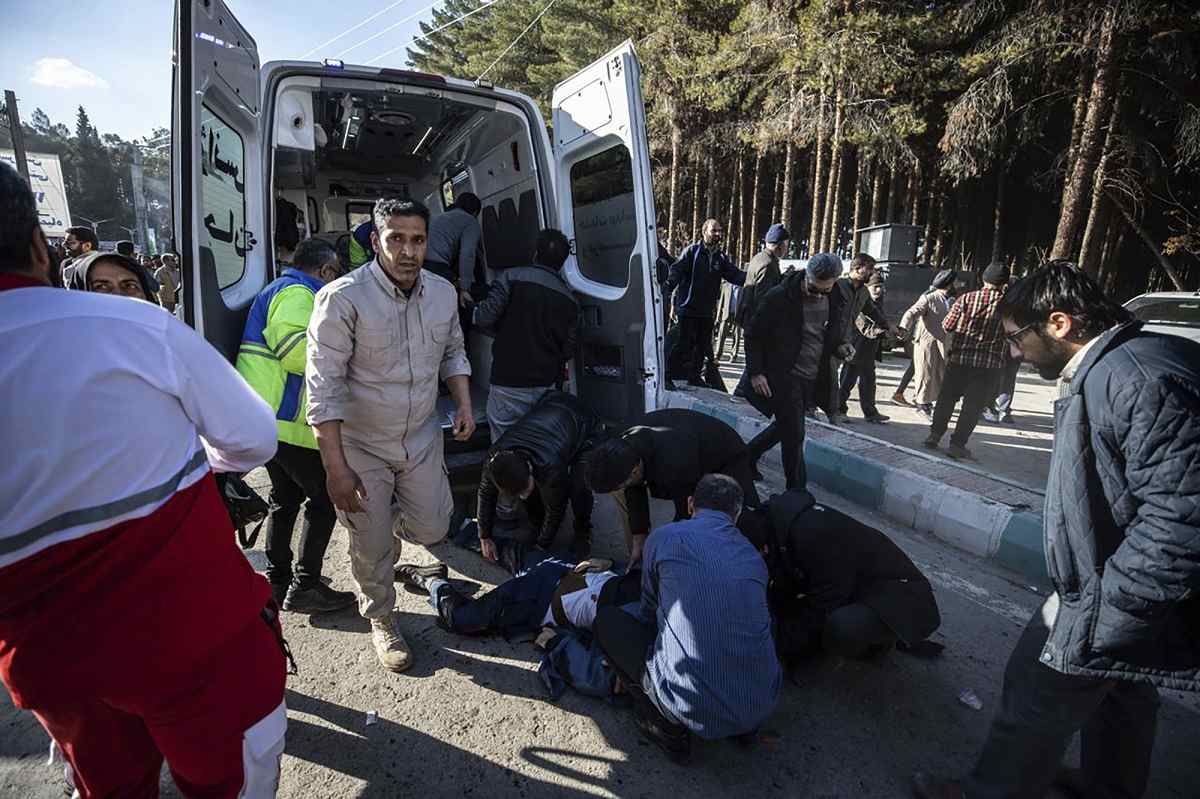
Injured people get aid after an explosion in Kerman, Iran, Wednesday, Jan. 3, 2024. Iran says the deadly twin bomb blasts occurred at an event honoring a prominent Iranian general slain in a U.S. airstrike in 2020.
9:11 JST, January 4, 2024
DUBAI, United Arab Emirates (AP) — Two bombs exploded and killed at least 95 people Wednesday at a commemoration for a prominent Iranian general slain by the U.S. in a 2020 drone strike, Iranian officials said, as the Middle East remains on edge over Israel’s war with Hamas in Gaza.
No one immediately claimed responsibility for what appeared to be the deadliest militant attack to target Iran since its 1979 Islamic Revolution. Iran’s leaders vowed to punish those responsible for the blasts, which wounded at least 211 people.
The blasts were minutes apart and shook the city of Kerman, about 820 kilometers (510 miles) southeast of the capital, Tehran. The second blast sprayed shrapnel into a screaming crowd fleeing the first explosion.
An earlier death toll of 103 was revised lower after officials realized that some names had been repeated on a list of victims, Iran’s health minister, Bahram Einollahi, told state TV. Many of the wounded were in critical condition, however, so the death toll could rise.
The gathering marked the fourth anniversary of the killing of Gen. Qassem Soleimani, the head of the Revolutionary Guard’s elite Quds Force, in a U.S. drone strike in Iraq. The explosions occurred near his grave site as long lines of people gathered for the event.
Iranian state television and officials described the attacks as bombings, without immediately giving clear details of what happened. The attacks came a day after a deputy head of the Palestinian militant group Hamas was killed in a suspected Israeli strike in Beirut.
The first bomb Wednesday was detonated around 3 p.m., and the other went off some 20 minutes later, the Iranian interior minister, Ahmad Vahidi, told state television. He said the second blast killed and wounded the most people.
Images and video shared on social media appeared to correspond with the accounts of officials, who said the first blast happened about 700 meters (765 yards) from Soleimani’s grave in the Kerman Martyrs Cemetery near a parking lot. The crowd then rushed west along Shohada Street, where the second blast struck about 1 kilometer (0.62 miles) from the grave.
A delayed second explosion is often used by militants to inflict more casualties by targeting emergency personnel responding to an attack.
Iranian state TV and state-run IRNA news agency quoted emergency officials for the casualty figures. Authorities said Thursday would be a national day of mourning.
Iran’s Supreme Leader Ayatollah Ali Khamenei said the attackers will face “a harsh response,” though he didn’t name any possible suspect. Iranian President Ebrahim Raisi added: “Undoubtedly, the perpetrators and leaders of this cowardly act will soon be identified and punished.”
Iran has multiple foes who could be behind the assault, including exile groups, militant organizations and state actors.
While Israel has carried out attacks in Iran over its nuclear program, it has conducted targeted assassinations, not mass casualty bombings. A U.S. State Department spokesman, Matthew Miller, said American officials had “no reason” to believe Israel was involved in Wednesday’s attack in Iran.
Sunni extremist groups including the Islamic State group have conducted large-scale attacks in the past that killed civilians in Shiite-majority Iran, though not in relatively peaceful Kerman.
Iran also has seen mass protests in recent years, including those over the death of 22-year-old Mahsa Amini in 2022. The country also has been targeted by exile groups in attacks dating back to the turmoil surrounding its 1979 Islamic Revolution.
Iran itself has been arming militant groups over the decades, including Hamas, the Lebanese Shiite militia Hezbollah and Yemen’s Houthi rebels. As Israel wages its devastating war in Gaza after Hamas’ Oct. 7 attacks that killed 1,200 people, both Hezbollah and the Houthis have launched attacks targeting Israel that they say come on behalf of the Palestinians.
Israel is suspected of launching the attack Tuesday that killed a deputy head of Hamas in Beirut, but that attack caused limited casualties in a densely populated neighborhood of the Lebanese capital. Last week, a suspected Israeli strike killed a Revolutionary Guard commander in Syria.
A Houthi spokesman, Mohammed Abdel-Salam, sought to link the bombings to Iran’s “support for the resistance forces in Palestine and Lebanon,” though he did not specifically blame anyone for the attack.
In Beirut, Hezbollah leader Hassan Nasrallah called the people who died in the attacks “martyrs who died on the same road, cause and battle that was led by” Soleimani.
The government of neighboring Iraq expressed condolences to the victims, and the European Union issued a statement offering “its solidarity with the Iranian people.”
Soleimani was the architect of Iran’s regional military activities and is hailed as a national icon among supporters of Iran’s theocracy. He also helped secure Syrian President Bashar Assad’s government after the 2011 Arab Spring protests against him turned into a civil, and later a regional, war that still rages today.
Soleimani had been relatively unknown in Iran until the 2003 U.S. invasion of Iraq. His popularity and mystique grew after American officials called for his killing over his help in arming militants with penetrating roadside bombs that killed and maimed U.S. troops.
A decade and a half later, Soleimani had become Iran’s most recognizable battlefield commander. He ignored calls to enter politics but grew as powerful, if not more so, than its civilian leadership.
Ultimately, a drone strike launched by the Trump administration killed the general, part of escalating incidents that followed America’s 2018 unilateral withdrawal from Tehran’s nuclear deal with world powers.
Soleimani’s death has drawn large processions in the past. At his funeral in 2020, a stampede broke out in Kerman and at least 56 people were killed and more than 200 were injured as thousands thronged the procession.
Until Wednesday, the deadliest attack to strike Iran since the revolution was the 1981 truck bombing of the Islamic Republican Party’s headquarters in Tehran. That attack killed at least 72 people, including the party’s leader, four government ministers, eight deputy ministers and 23 parliament members.
In 1978 just ahead of the revolution, an intentionally set fire at the Cinema Rex in Abadan killed hundreds of people.
"News Services" POPULAR ARTICLE
-

American Playwright Jeremy O. Harris Arrested in Japan on Alleged Drug Smuggling
-

Japan’s Nikkei Stock Average as JGB Yields, Yen Rise on Rate-Hike Bets
-

Japan’s Nikkei Stock Average Licks Wounds after Selloff Sparked by BOJ Hike Bets (UPDATE 1)
-

Japanese Bond Yields Zoom, Stocks Slide as Rate Hike Looms
-

Japan’s Nikkei Stock Average Buoyed by Stable Yen; SoftBank’s Slide Caps Gains (UPDATE 1)
JN ACCESS RANKING
-

Keidanren Chairman Yoshinobu Tsutsui Visits Kashiwazaki-Kariwa Nuclear Power Plant; Inspects New Emergency Safety System
-

Imports of Rare Earths from China Facing Delays, May Be Caused by Deterioration of Japan-China Relations
-

University of Tokyo Professor Discusses Japanese Economic Security in Interview Ahead of Forum
-

Japan Pulls out of Vietnam Nuclear Project, Complicating Hanoi’s Power Plans
-

Govt Aims to Expand NISA Program Lineup, Abolish Age Restriction


